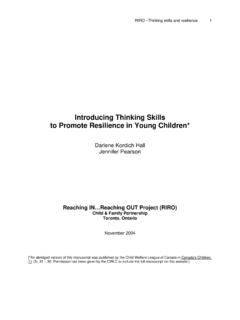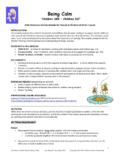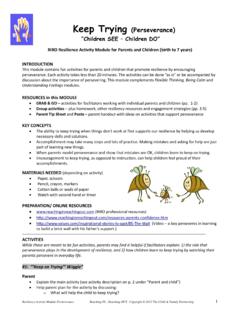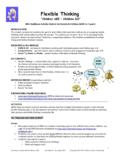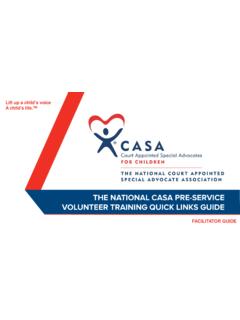Transcription of “Children SEE – Children DO”
1 Resiliency Activity Module-UNDERSTANDING FEELINGS Reaching OUT, Copyright 2012 The Child & Family Partnership 1 Understanding Feelings (Empathy) Children SEE Children DO RIRO Resilience Activity Module for Parents and Children (birth to 7 years) INTRODUCTION This module contains fun activities for parents and Children that promote resilience by supporting the development of empathy and understanding. Each activity takes less than 20 minutes. The activities can be done as is or be accompanied by discussion about the importance of empathy. This module complements the Participation & Helping Out, Being Calm and Positive Outlook modules.
2 RESOURCES in this MODULE GRAB & GO activities for facilitators working with individual parents and Children (pp. 1-3) Group activities plus homework, other resiliency resources and engagement strategies (pp. 4-7) Feeling Faces chart resources for Activity #3 (p. 8) Parent T ip Sheet and Poster parent handout with ideas on building empathy and understanding KEY CONCEPTS Being able to recognize and interpret emotions in ourselves and others is the basis for empathy and understanding both are critical abilities that support resilience. Parents can help Children learn to recognize and interpret emotions by offering practice opportunities.
3 When parents model empathy and understanding in everyday life, Children feel accepted, understood and learn to understand themselves and others. Children respond emotionally to their parents emotions and actions. They pick up on their parents interpretations of their own and others emotions and intentions. MATERIALS NEEDED (depending on activity) Cotton balls Mirror Chart: Feeling Faces Parent T ip Sheet PREPARATION/ONLINE RESOURCES about RESILIENCE (RIRO professional resources) ---------------------------------------- ---------------------------------------- ----------------------------------- ACTIVITIES While these are meant to be fun activities, parents may find it helpful if facilitators explain.
4 1) the role that recognizing and understanding emotions have in the development of resilience, and 2) how Children learn about empathy and understanding by watching their parents feelings and actions in everyday life. #1: Feelings Face Painting (This activity draws attention to the areas of the face used for emotional expression.) Parent Demonstrate using a dry cotton ball to paint emotions (faces) on the facilitator s face. Ask parent to take a cotton ball and draw an emotion on his/her own face. Resiliency Activity Module-UNDERSTANDING FEELINGS Reaching OUT, Copyright 2012 The Child & Family Partnership 2 Ask parent to identify what his/her face feels when an emotion is drawn on it.
5 Describe what facilitator sees on the parent s face (with or without using a mirror to show the parent). Discuss how Children see and respond to their parents feelings. Discuss how parents can learn to recognize their Children s feelings. Suggest parent do a cotton ball paint activity with his/her child. Parent and Child Ask parent and child to sit across from each other with a pretend jar of paint between them. Ask parent to use a cotton ball to paint an emotion on the child s face. Parent is asked to tell child what s/he is painting and to name the emotion, , I drew a smile. OR I drew a frown on your face.
6 OR I painted a sad face. Then instruct parent to ask the child to paint the parent s face. Depending on child's age, the child may: o Just scribble o Copy the parent by painting the emotion face the parent has modeled for them. Parent can then describe the emotion and the face by saying, , I am smiling you are painting on my happy face. o Paint an emotion and tell the parent what the emotion is. #2: Imitation Game (This activity helps develop awareness of one s own emotional expression and promotes understanding of a child s response to copying a parent s emotional expression.) Parent Option #1: Using a mirror, ask parent to watch him/herself making faces for these emotions: sad mad nervous happy calm scared excited embarrassed confused OR Option #2: (for parents who may be uncomfortable in expressing emotions) Have parent look at faces with intense emotions for 20 seconds (use a magazine or facilitator can create a resource).
7 Ask parent to identify any changes in his/her emotional state or body after looking at the face. Draw attention to any changes seen in the parent s face or body. Try to name the emotion (facilitator may pick from list above). Parent and Child Ask parent to make a feeling face and then ask the child to copy it. Child copies face and parent asks child to guess what the face is feeling. If child is able, s/he can make faces and ask parent to copy and guess the feeling. Next, parent can make faces representing other emotions and repeat activity. # 3: Name that Feeling Face (This activity offers practice in attending to and identifying feelings.)
8 Parent Ask parent to look through a book or magazine and name the feelings in the faces. Resiliency Activity Module-UNDERSTANDING FEELINGS Reaching OUT, Copyright 2012 The Child & Family Partnership 3 Parent is asked to practice making these feeling faces. Have parent guess the feeling or choose feeling words from a list. Ask parent to look for faces that show the same emotion. Parent and Child Ask parent to look through a book or magazine and name the feelings in the faces for the child. Have parent and child imitate the faces while looking at each other (being silly helps). Option 1: Ask parent and child to look for faces that show the same emotion.
9 Option 2: Ask parent to use the Feeling Faces chart (p. 8) for this activity instead of a magazine. Note: The Name that Feeling Face activity is less personal and may be better accepted if parent is uncomfortable with emotions and/or touch. #4: Parent and Infant Activities Ask parent to: o make exaggerated faces for his/her infant to see and copy. o let the baby touch the parent s face as s/he makes different faces. o make frequent eye contact with the baby. Resiliency Activity Module-UNDERSTANDING FEELINGS Reaching OUT, Copyright 2012 The Child & Family Partnership 4 GROUP ACTIVITIES NOTE: These activities are designed for professionals and paraprofessionals who have completed RIRO Resiliency Skills Training Program and who have group facilitation experience.
10 Parent group (no Children ) Option #1: Facilitator demonstrates using a cotton ball to paint feelings faces on his/her own face. Parent takes a cotton ball and draws a feeling on his/her own face. Parent identifies what his/her face feels when an emotion is drawn on it. Facilitator can demonstrate facial feelings and body language and have parents guess the feeling. (This is a good opportunity to role model flexible thinking and handling mistakes , , wrong guesses are OK.) Discuss how Children see and respond to parents feelings. Discuss that parents can learn to recognize their Children s feelings.

